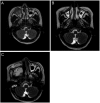Treatment outcome of maxillary sinus cancer
- PMID: 21139915
- PMCID: PMC2994449
- DOI: 10.4081/rt.2009.e36
Treatment outcome of maxillary sinus cancer
Abstract
The standard treatment in the early stage of maxillary sinus cancer is surgical resection followed by postoperative radiation therapy. However, for locally advanced maxillary sinus cancer, a multimodality treatment approach is strongly recommended to improve the survival rate and quality of life of the patient. We determined the treatment outcomes of induction chemotherapy, concurrent chemoradiation therapy, and surgical resection for locally advanced maxillary sinus cancer. Forty-four patients with locally advanced maxillary sinus cancer, who had been treated between January 1990 and April 2008 at Kangnam St. Mary's Hospital, were retrospectively analyzed. The objective response rates were 70%, 53%, and 57% in the intra-arterial induction chemotherapy, intravenous induction chemotherapy, and concurrent chemoradiation therapy groups, respectively. The orbital preservation rates were 83%, 100%, and 75% in the intra-arterial induction chemotherapy, intravenous induction chemotherapy, and surgical resection groups, respectively. In seven of nine patients in whom the orbit could be preserved after induction chemotherapy, the primary tumors were removed completely. However, although the orbits were preserved in three patients who underwent surgical resection as a primary treatment, all three cases were confirmed to be incomplete resections. We found that active induction chemotherapy for locally advanced cancer of the maxillary sinus increased the possibility of complete resection with orbital preservation as well as tumor down-staging.
Keywords: induction chemotherapy; intra-arterial chemotherapy; maxillary sinus cancer; organ preservation..
Conflict of interest statement
Conflict of interest: the authors report no conflicts of interest.
Figures



Similar articles
-
A clinical study of multimodal treatment for orbital organ preservation in locally advanced squamous cell carcinoma of the nasal cavity and paranasal sinus.Jpn J Clin Oncol. 2016 Aug;46(8):727-34. doi: 10.1093/jjco/hyw064. Epub 2016 May 20. Jpn J Clin Oncol. 2016. PMID: 27207888
-
Craniofacial Resection for T4 Maxillary Sinus Carcinoma: Managing Cases with Involvement of the Skull Base.Otolaryngol Head Neck Surg. 2015 Aug;153(2):231-8. doi: 10.1177/0194599815586770. Epub 2015 Jun 4. Otolaryngol Head Neck Surg. 2015. PMID: 26044790
-
Organ preservation treatment using TPF-a pilot study in patients with advanced primary and recurrent cancer of the oral cavity and the maxillary sinus.Oral Maxillofac Surg. 2009 Jun;13(2):87-93. doi: 10.1007/s10006-009-0159-3. Oral Maxillofac Surg. 2009. PMID: 19430823 Clinical Trial.
-
Current Standards for Organ Preservation in Locoregionally Advanced Non-nasopharyngeal Head and Neck Cancer and Evolving Strategies for Favorable-Risk and Platinum-Ineligible Populations.Curr Treat Options Oncol. 2019 Dec 4;20(12):89. doi: 10.1007/s11864-019-0688-4. Curr Treat Options Oncol. 2019. PMID: 31797157 Review.
-
Functional organ preservation in locally advanced laryngeal squamous cell carcinoma: is there a role for induction chemotherapy?Clin Oncol (R Coll Radiol). 2013 May;25(5):298-307. doi: 10.1016/j.clon.2012.12.001. Epub 2013 Jan 3. Clin Oncol (R Coll Radiol). 2013. PMID: 23290343 Review.
Cited by
-
Carcinoma of Maxillary Sinus Masquerading as Odontogenic Infection.J Clin Diagn Res. 2016 Sep;10(9):ZD11-ZD13. doi: 10.7860/JCDR/2016/21256.8520. Epub 2016 Sep 1. J Clin Diagn Res. 2016. PMID: 27790593 Free PMC article.
-
Occupational Exposure to Wood Dust and the Burden of Nasopharynx and Sinonasal Cancer in Canada.Int J Environ Res Public Health. 2022 Jan 20;19(3):1144. doi: 10.3390/ijerph19031144. Int J Environ Res Public Health. 2022. PMID: 35162168 Free PMC article.
-
Radiotherapy in late elderly (aged 75 or older) patients with paranasal sinus carcinoma: a single institution experience.Eur Arch Otorhinolaryngol. 2016 Dec;273(12):4485-4492. doi: 10.1007/s00405-016-4151-x. Epub 2016 Jun 17. Eur Arch Otorhinolaryngol. 2016. PMID: 27314860
-
Regression of advanced maxillary sinus cancer with orbital invasion by combined chemotherapy and immunotherapy: A one-year follow-up case report.Mol Clin Oncol. 2022 Apr;16(4):94. doi: 10.3892/mco.2022.2527. Epub 2022 Mar 1. Mol Clin Oncol. 2022. PMID: 35350406 Free PMC article.
-
Combination treatment with paclitaxel, carboplatin and cetuximab in maxillary sinus cancer: A case report.Oncol Lett. 2024 Jan 10;27(3):93. doi: 10.3892/ol.2024.14226. eCollection 2024 Mar. Oncol Lett. 2024. PMID: 38288039 Free PMC article.
References
-
- Dulguerov P, Jacobsen MS, Allal AS, et al. Nasal and paranasal sinus carcinoma: are we making progress? A series of 220 patients and a systematic review. Cancer. 2001;92:3012–29. - PubMed
-
- Spiro JD, Soo KC, Spiro RH. Squamous carcinoma of the nasal cavity and paranasal sinuses. Am J Surg. 1989;158:328–32. - PubMed
-
- Nishino H, Ichimura K, Tanaka H, et al. Results of orbital preservation for advanced malignant maxillary sinus tumors. Laryngoscope. 2003;113:1064–9. - PubMed
-
- Samant S, Robbins KT, Vang M, et al. Intra-arterial cisplatin and concomitant radiation therapy followed by surgery for advanced paranasal sinus cancer. Arch Otolaryngol Head Neck Surg. 2004;130:948–55. - PubMed
-
- Monnerat C, Faivre S, Temam S, et al. End points for new agents in induction chemotherapy for locally advanced head and neck cancers. Ann Oncol. 2002;13:995–1006. - PubMed
LinkOut - more resources
Full Text Sources
Other Literature Sources
Miscellaneous

